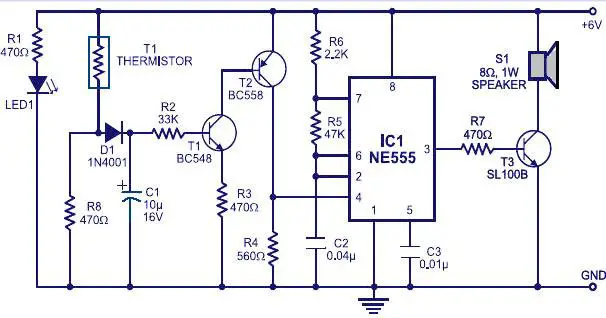Thursday, April 11, 2013
Browse »
home»
alarm
»
fire
»
ne555
»
thermistor
»
using
»
Fire alarm using thermistor NE555

Notes.
Fire alarm using thermistor NE555
Many fire alarm circuits are presented
here,but this time a new circuit using a thermistor and a timer to do
the trick. The circuit is as simple and straight forward so that, it
can be easily implemented. The thermistor offers a low resistance at
high temperature and high resistance at low temperature. This
phenomenon is employed here for sensing the fire.
here,but this time a new circuit using a thermistor and a timer to do
the trick. The circuit is as simple and straight forward so that, it
can be easily implemented. The thermistor offers a low resistance at
high temperature and high resistance at low temperature. This
phenomenon is employed here for sensing the fire.
The
IC1 (NE555) is configured as a free running oscillator at audio
frequency. The transistors T1 and T2 drive IC1. The output (pin 3) of
IC1 is couples to base of transistor T3 (SL100), which drives the
speaker to generate alarm sound. The frequency of NE555 depends on the
values of resistances R5 and R6 and capacitance C2. When thermistor
becomes hot, it gives a low-resistance path for the positive voltage to
the base of transistor T1 through diode D1 and resistance R2.
Capacitor C1 charges up to the positive supply voltage and increases
the the time for which the alarm is ON. The larger the value of C1, the
larger the positive bias applied to the base of transistor T1 (BC548).
As the collector of T1 is coupled to the base of transistor T2, the
transistor T2 provides a positive voltage to pin 4 (reset) of IC1
(NE555). Resistor R4 is selected s0 that NE555 keeps inactive in the
absence of the positive voltage. Diode D1 stops discharging of
capacitor C1 when the thermistor is in connection with the positive
supply voltage cools out and provides a high resistance path. It also
inhibits the forward biasing of transistor T1.
Circuit diagram with Parts list. IC1 (NE555) is configured as a free running oscillator at audio
frequency. The transistors T1 and T2 drive IC1. The output (pin 3) of
IC1 is couples to base of transistor T3 (SL100), which drives the
speaker to generate alarm sound. The frequency of NE555 depends on the
values of resistances R5 and R6 and capacitance C2. When thermistor
becomes hot, it gives a low-resistance path for the positive voltage to
the base of transistor T1 through diode D1 and resistance R2.
Capacitor C1 charges up to the positive supply voltage and increases
the the time for which the alarm is ON. The larger the value of C1, the
larger the positive bias applied to the base of transistor T1 (BC548).
As the collector of T1 is coupled to the base of transistor T2, the
transistor T2 provides a positive voltage to pin 4 (reset) of IC1
(NE555). Resistor R4 is selected s0 that NE555 keeps inactive in the
absence of the positive voltage. Diode D1 stops discharging of
capacitor C1 when the thermistor is in connection with the positive
supply voltage cools out and provides a high resistance path. It also
inhibits the forward biasing of transistor T1.

Notes.
- The circuit can be powered from a 6V battery or a 6V power supply.
- Click Here ! for the circuit diagram of a power supply circuit for this project.
- The thermistor can be mounted on a heat resistant material like mica to prevent it from damage due to excessive heat.
- The LED acts as an indication when the power supply is switched ON.
Labels:
alarm,
fire,
ne555,
thermistor,
using
Subscribe to:
Post Comments (Atom)
No comments:
Post a Comment
Note: Only a member of this blog may post a comment.